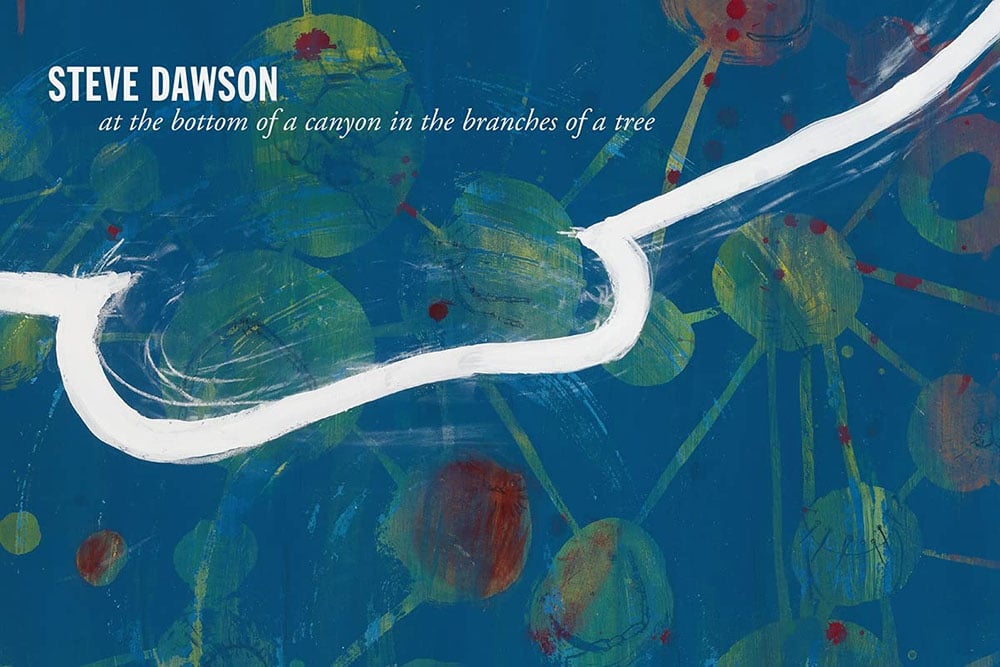
Last year, Steve Dawson released Last Flight Out, officially credited to Steve Dawson and Funeral Bonsai Wedding. Like the previous self-titled Funeral Bonsai Wedding album, Last Flight Out fused Dawson’s songwriting smarts with a jazzy folk style reminiscent of Van Morrison’s low-key masterpieces Astral Weeks and Veedon Fleece. String ensembles and vibraphone pushed the arrangements into a mystical territory, and the album became one of the most acclaimed of Dawson’s lengthy, varied career.
With At the Bottom of a Canyon in the Branches of a Tree, Dawson moves in another direction. The style is more reminiscent of the Americana and roots-tinged leanings of Dolly Varden, the band Dawson formed with this wife Diane Christiansen in the mid-‘90s. In that sense, it’s a bit of a full circle for this exceptionally eclectic songwriter and musician, who seems dead set on avoiding labels and genre classifications.
Last year, Dawson was given an Esteemed Artist Award from the City of Chicago, which came with $10,000 in grant funds. That helped him complete the new album, a home studio recording, and a solo work in the truest sense of the word. Dawson plays everything you hear, except for Alton Smith’s piano on two songs and Michael Miles and Christiansen contributing banjo and vocals, respectively, on one song each. That’s particularly impressive when you consider the skill and fluidity in the instrumentation throughout the entire record. What sounds like a terrific band clicking from the very beginning is the result of painstaking overdubbing. It’s not exactly a new concept, but Dawson’s execution is pretty spectacular.
Anyone expecting a sonic soundalike to Last Flight Out will be pleasantly surprised and how deftly Dawson handles this different approach. The two albums are wonderful in their own ways. At the Bottom of a Canyon seems deeply inspired by ‘60s and ‘70s folk-rock, with lots of acoustic guitars meshing with the nostalgic sounds of a Wurlitzer keyboard and more exotic instrumentation like harmonium and dulcimer. The smooth, low-key “This Is All There Is” opens the album with a combination of funk-like swagger and warm analog production, like Warren Zevon recording an Al Green song in 1976.
But this isn’t some cheap retro guilty pleasure – Dawson’s arrangements and songwriting are too sophisticated for that. The single “22 Rubber Bands” is a winsome, acoustic guitar-driven gem with gorgeous touches like shimmering organ, warm harmonies, and a deeply felt falsetto. Dawson dives into a rustic folk vibe with “We Are Walking in a Forest”, a duet with Christiansen that incorporates light, ethereal keyboard touches that defy classification and avoid stylistic pigeonholing. The harmonies here – and throughout the album – recall vintage Crosby, Stills, Nash & Young but still manage to sound fresh and new. Darting around between genres, Dawson even sneaks in a brief, lovely acoustic guitar instrumental, “Above the Falls”, giving the album a dream-like interlude.
The closest Dawson gets to the Funeral Bonsai Wedding sound is on the haunting “I Will Never Stop Being Sorry”. It’s an eloquent slice of chamber folk-pop complete with bits of mellotron and accordion, as well as lyrics that bring to mind bits of Gothic horror. “But who are these ghosts / Who plot and who plan / Who stomp ‘round the room / With their sacks full of sand?” Despite these intoxicating, baroque digressions, Dawson seems perfectly content with keeping At the Bottom of a Canyon locked into a slightly more traditional rock/folk/soul setting. That’s evidenced by songs like the hip-swaying “Time to Remember”, which blends funk-tinged organs with Dawson’s typically adept vocal harmonies.
On this album and all his previous ones, Steve Dawson embraces the best aspects of an eclectic artist. His songs employ a genuine sophistication but are easy to fall in love with. His stylistic shifts are consistently engaging, inviting the listener along for an unpredictable and enjoyable ride. It’s hard to guess what his next album will sound like, and that’s part of the fun.


![Call for Papers: All Things Reconsidered [MUSIC] May-August 2024](https://www.popmatters.com/wp-content/uploads/2024/04/all-things-reconsidered-call-music-may-2024-720x380.jpg)



